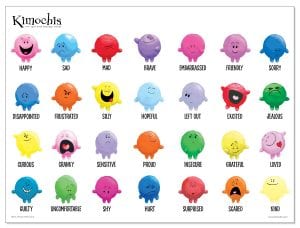Identifying Feelings
SEL Outreach Newsletter October
During October and November, we will be working on the theme, “Identifying Feelings”. This theme helps students work towards accomplishing some of the goals in the Social-Emotional Development Report Card Standards: Social Awareness and Self Management.
WHY Identifying Feelings? Identifying feelings is a critical part of all students’ development, but there are many aspects of feeling identification. During October and November, we will try to help students improve their emotional vocabulary. Often times, students use the “main” emotions: happy, sad, mad…but there are so many more! We would like students to increase their feelings vocabulary, while understanding that all emotions are normal to feel.

Linking feelings to triggers: If students can’t identify their own feelings, they are unable to figure out what makes them happy, what irritates them, or what makes them mad. It is also crucial that students learn to relate their feelings to a trigger. One of the skills we work on is students being able to share why they feel a certain way. Instead of just saying, “I feel happy”, they could say, “I feel happy because I got to make a new friend at recess”. This is especially challenging for our younger students. Parents, family members, other students and staff can all be excellent role models for this! One emotion, anger, is sometimes referred to as a “secondary” emotion…this is because we often use anger as a disguise for other, more raw emotions. If we make the discussion of feelings more commonplace for our students, they are more likely to feel more comfortable using accurate descriptions of their feelings. If we are better able to describe specific emotions, and identify triggers, we can know better what to do with them.
I-Messages: ‘I’ messages are a tool that defuse conflict by avoiding accusatory language. ‘You’-messages suggest blame, and encourage the recipient to deny wrong-doing or to blame back. For example, if you say, “You broke your promise,” the answer is often times, “No, I didn’t,” which sets both people involved up for an argument. Alternatively, the other individual might deflect the blame with, “Well, you did, too,”…but this also continues the conflict. I-messages simply state a problem, without blaming someone for it. This makes it easier for the other side to help solve the problem, and encourages empathy by helping both sides to understand the feelings involved. If you say, “I felt disappointed or let down,” rather than, “You broke your promise,” you will convey the same information…but you will do so in a way that is less likely to provoke a defensive or hostile reaction from the other person involved. Remembering to use I-messages can be difficult, because many people are not used to talking about their feelings so openly. This is why it is so important that we start this practice young, and that adults role model this technique (especially when they are upset!). See more below:
Parent/guardian summary on I-Messages
When used correctly, ‘I’ messages foster positive communication in relationships, and help teach empathy. Sharing feelings and thoughts in an honest and open manner can help parents/guardians and children grow closer on an emotional level. In fact, ‘I’ messages are effective in all relationships, and are an important step in problem solving with adults and peers.
Thanks for reading! Let me know if you have any questions or concerns! -Kait
